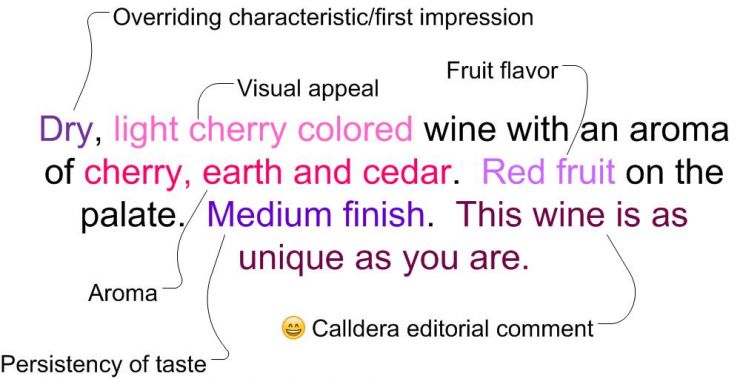A Common Language for Wine Descriptions Fosters Understanding
How many times have you read a wine description and thought to yourself, “What does that mean?”? A string of fancy words, such as “Hint of cassis and lingonberry with after tones of bacon, espresso and tobacco box“ sounds impressive but does not convey much meaning to most people. For this example, if you happen to have ever eaten a black currant (flavor of cassis) or a lingonberry, you might have an idea of the fruit flavors in the described wine, but it’s unlikely you’ve eaten black currents and lingonberries with bacon while simultaneously sipping an espresso and sniffing a box of cigars.
What are the characteristics of a good wine description?
A good wine description should include the following...
- An overridding characteristic/first impression of the wine when tasted
- Information regarding the color/visual appeal of the wine
- The wine's aroma
- The predominant fruit flavor of the wine
- The wine's taste persistency (i.e., how long does the wine's fruit flavor linger in your mouth?)
Wine descriptions should be straightforward and consistent
A simple, common language for wine descriptions is needed. Ideally, this language has a limited vocabulary of words whose meanings remain consistent from one description to the next.
For example and as an analogy, consider the color of the sky. On a beautiful sunny day, one could say, “The sky is a beautiful azure with the occasional white wisp of a vapor trail.” However, without loss of pertinent information, one could simply say, “The sky is blue.”
Similarly, on a cloudy morning, one could say, “Strings of grey and white stratus engulf the atmosphere leaving transitory patches of blue.” Or one could simply say, “Grey and white clouds crowd the morning sky.”
The venue for beautiful language is poetry, music and romance. The language for understanding and communicating about everyday aspects of life, such as what we eat and drink, must be straight forward and consistent.
Wine descriptions should contain pertinent, easily understandable information
The value of a wine description is to provide enough information for you to make an informed choice. Specifically, you want to know in simple, consistently used terms if the wine has a combination of visual appeal, aromas, flavors, persistency of taste and an overriding characteristic (such as “fruit forward”) you personally find appealing. Any information beyond that is confusing and counterproductive.

Visual appeal is a consideration
As the saying goes, “We eat with our eyes first.” This adage applies to drink as well. The color of wine is an integral part of the consumption experience. A light cherry colored wine may signify a perfect match to a light meal, whereas a deep purple colored wine may inspire you to curl up on the couch with a good book.
Perceptions of taste are best communicated with simple, consistent descriptors
The tastes we perceive with our mouths are quite limited – sweet, sour, bitter, salty and (some would argue) savory/umami. Most of what we perceive as taste actually comes from our sense of smell. When you sip from a glass of wine, you inhale the aromas in the wine. Therefore, knowing what smells are present in a wine before you purchase it is helpful shopping information.
You need consistent terminology to be able to compare the taste of different wines. For most, it is sufficient to distinguish among a handful of distinct fruit flavors detectable in wine.
For example, if you prefer “black fruit” flavors, such as blackberries, blueberries and plums, over “red fruit” flavors, such as strawberries, raspberries and cherries, it is helpful for a wine description to state “black fruit” or “red fruit” when the description applies. Given consistent terminology, you immediately understand how a wine with a fruit flavor described as “black fruit” will taste versus how a wine whose fruit flavor is described as “red fruit” will taste. You shouldn’t have to be able to discern the nuances of individual berry flavors in a wine whose flavor easily can be described as “black fruit.”
Limiting the universe of possible descriptors and using simple terms, such as “black fruit” and “red fruit,” conveys needed information without overwhelming you with detail or requiring you to be a super taster.
Use of consistent fruit flavor taste descriptors also prevents you from falling into the trap of assuming grape variety equates to fruit flavor. Growing conditions, harvest practices and wine production techniques result in a variety of distinctly flavored wines made from the same grape variety (click here to learn more).
Persistency of taste may correlate with occassion
Persistency of taste in a wine, described as “short,” “medium,” “lingering,” etc., is valuable information. Sometimes there is a preference for wines with short persistency, as these wines may be perceived as light and refreshing. At other times, it is nice to savor a wine whose flavor hangs around in your mouth for a while.
Overriding characteristic garners your attention
The first sip of a wine leaves an impression. It may seem dry. It may make your mouth pucker. It may be a fruit explosion in your mouth. It may seem thick. You may find it thin and watery. Generally, there is some overriding characteristic, a first impression, that strikes you. This is good information to know about the wine before you purchase it to ensure it will meet your expectations.
Calldera wine descriptions use a consistent format and descriptive terminology
Calldera wine descriptions are crafted to aid you with your purchasing decisions. Each description includes simple, consistently used terms describing the visual appeal, aroma, flavor, persistency of taste and an overriding characteristic of the wine.
These straightforward and internally consistent descriptions allow you to make meaningful comparisons among the wines Calldera recommends to you.
This will allow you to refine wine selection by occasion, the fruit flavor that appeals to you at the moment or a wine “first impression,” aroma, visual or taste persistency that strikes your current fancy.
Let the wine speak for itself
Just because it’s always been done a certain way doesn’t mean it’s right. Embrace clarity and simplicity in wine selection.
Then let your enjoyment of wine inspire beautiful language.
"The venue for beautiful language is poetry, music and romance. The language for understanding and communicating about everyday aspects of life, such as what we eat and drink, must be straight forward and consistent."



